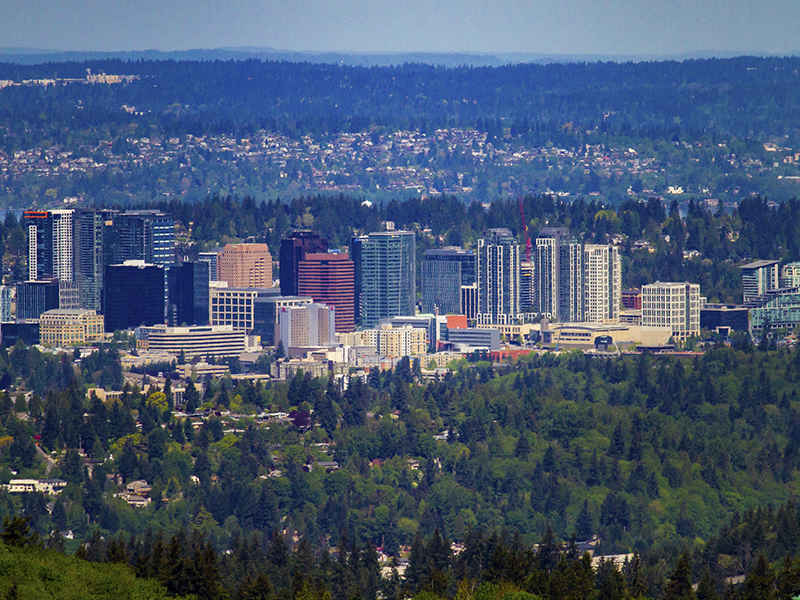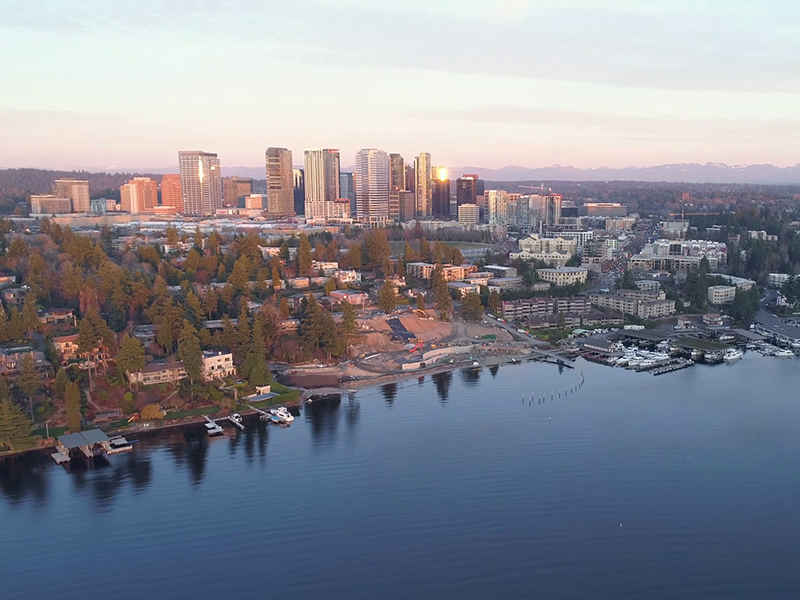Bellevue was settled in 1869 by William Meydenbauer and Aaron Mercer, who claimed homestead tracts several miles apart. Prior to the opening of the Lake Washington Floating Bridge in 1940, Bellevue was a rural area with little development. Although it was small, developers were pushing to change that; in the 1920s, James S. Ditty predicted that it would become a city with a population of 200,000. He envisioned plans that included the bridging of Lake Washington and an area filled with golf courses and airports. His map with these visions was published in 1928.
Once the Murrow Memorial Bridge opened, access from Seattle improved, and the area gradually grew into a bedroom community. After the Japanese internment began in 1942, a large quantity of farmland became available for development. This made way for the initial development of the Bellevue downtown area.
Bellevue seen from Meydenbauer Bay in 1902.
Bellevue incorporated as a third class city on the March 21, 1953. Following the 1963 opening of a second bridge across the lake, the Evergreen Point Floating Bridge, the city began to grow more rapidly. The Crossroads community was annexed in 1964. Lake Hills was annexed in 1969. By the 1970 census, Bellevue had become the fourth most populous city in the state of Washington, following only Seattle, Spokane, and Tacoma.


Bellevue remains one of the largest cities in the state, with several high-rise structures in its core and a burgeoning business community. The city experienced a building boom during the mid 2000s, with the building of developments such as Lincoln Square and the Bravern.
Reflective of Bellevue's growth over the years is Bellevue Square, now one of the largest shopping centers in the region. Opened in 1946, the mall underwent a significant expansion in the 1980s. More recently, an expansion along Bellevue Way called "The Lodge" and the new One Lincoln Tower promise to strengthen downtown Bellevue's role as the largest Seattle Eastside shopping and dining destination.
The city's long-term plans include the Bel-Red Corridor Project, a large-scale planning effort to encourage the redevelopment of a large northern section of the city bordering the adjacent town of Redmond which is a major employment area in the city. Patterned after what many civic leaders consider the successful redevelopment of the downtown core, early plans include "superblock" mixed use projects similar to Lincoln Square. Premised on the 2008 approval of the extension of Link Light Rail to the Eastside, the city hopes to mitigate transportation problems impeding earlier efforts in redeveloping the downtown core; viewed as an economic development opportunity by many in the business and building development community, the process has focused on infrastructure and the encouragement of private construction in a large-scale urban renewal effort.
We offer solutions for any moving needs. Our team is highly skilled in local moving, office moving, furniture hoisting, piano/pool table moving, packing, and so much more! Our facility is well equipped for for short and long term storage.